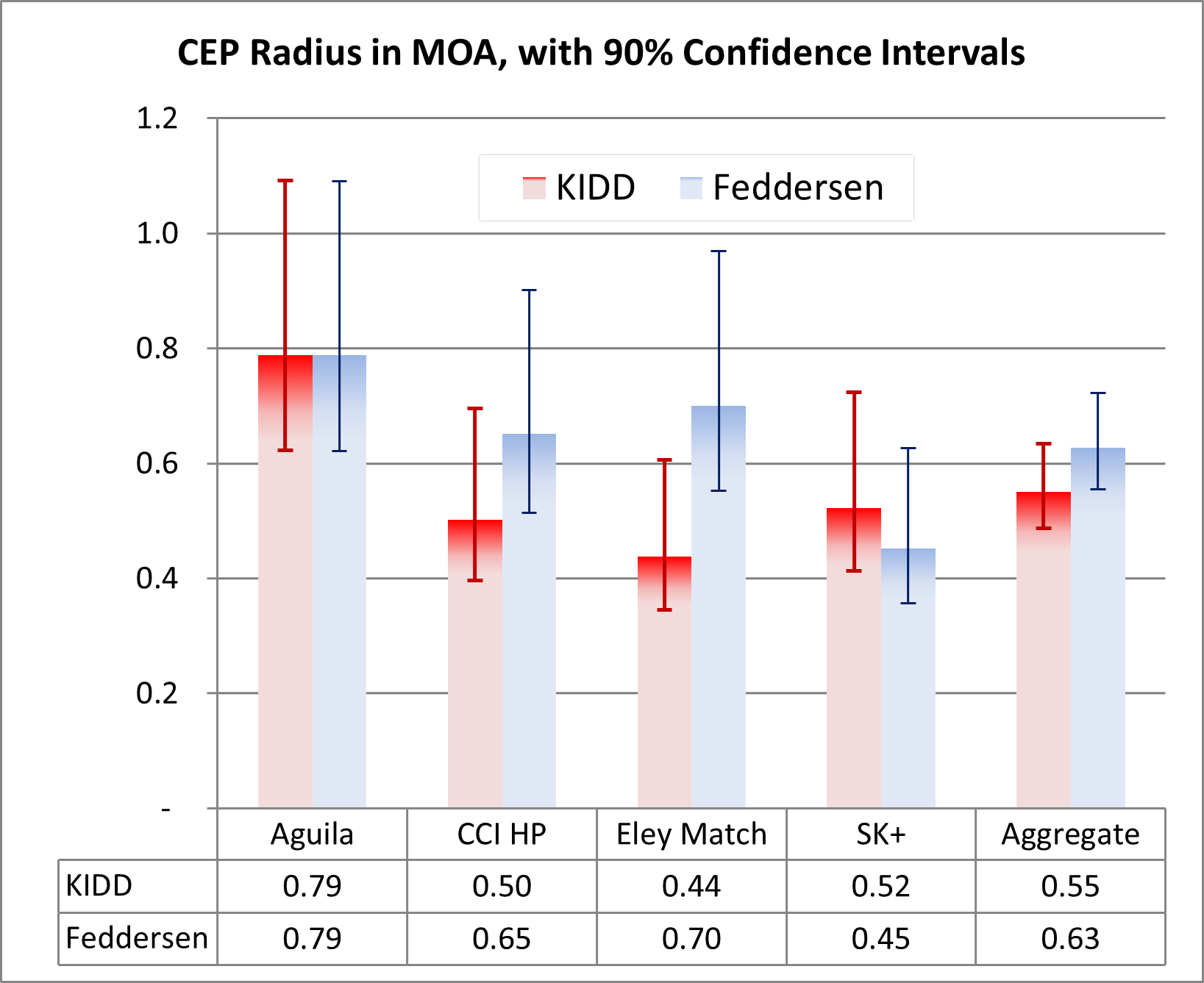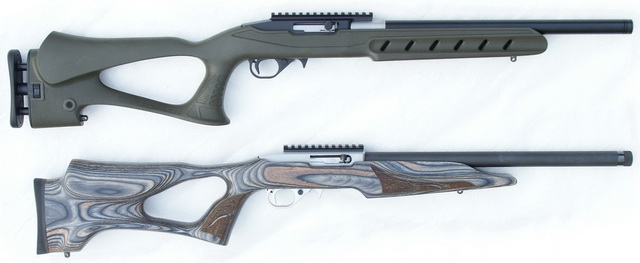These are both Ruger 10/22 style rifles built for shooting .22LR with maximum accuracy. On top is an $860 rifle built entirely by KIDD Innovative Design. The receiver and trigger are milled from aluminum, and the bolt from hardened steel. The single-stage trigger is also a crisply machined assembly that adjusts down to a pull of just 1.5 pounds. The lightweight barrel is guaranteed to group inside of half an inch at 50 yards. The gun here is screwed into a comfortable $100 ProMag Archangel Target stock
Do you have to spend $1000 to get an accurate .22 rifle? Expert barrel maker Fred Feddersen says one of his $170 barrels will turn an off-the-rack Ruger into a gun that can compete with any custom autoloader. So the second gun shown is a standard Ruger 10/22 receiver and bolt onto which I swapped Feddersen’s barrel. Of course I don’t think I can really shoot that well with a standard trigger, so to be fair I bought another $200 KIDD trigger assembly for it. The gun is shown here screwed into a beautiful $175 Tactical Solutions Vantage laminated stock.
Testing
The ammo shortage continues to plague the market for .22LR, so I consider myself lucky to still have four different types of ammo on hand. I screwed an AAC Element suppressor to each barrel, put each rifle in the Archangel stock, mounted the same high-power scope, and shot ten-round groups at 50 yards with the following subsonic 40gr loads:
- Eley Match
- SK+
- CCI HP
- Aguila SuperExtra
I have plenty of the Aguila on hand, so I used that for sighting and shot two groups with that. The Ruger/Feddersen fired all 50+ shots without any hiccups. The KIDD began to bog down at the end, experiencing a few failures to fire or extract on the Aguila. Cleaning the chamber and bolt face and testing some more showed it’s capable of running smoothly when clean, but evidently it doesn’t like too much of the copious .22LR fouling to build up. Do those tighter tolerances translate to higher precision?
The question of precision is a mathematically interesting one that has been embarrassingly neglected by the shooting industry, which is often content to simply measure the extreme spread of 3 to 5 shots and leave it at that. With 10 shots per group I have more statistically significant samples. I use OnTarget software to digitize the targets. It automatically calculates the sample radius and spread for each group. But those measures vary with the number of shots per group. As explained on Ballistipedia, when we test and compare precision we should use invariant and unbiased statistics like Circular Error Probable (CEP), which is the radius of a circle that we expect to cover exactly half the shots — no matter how many we fire. Daniel Wollschläger, a statistically savvy developer, has built an exceptional open-source web app based on R that takes the output of OnTarget and performs the difficult calculations to provide unbiased estimates of CEP (and many other statistics).
Having efficiently digested the shooting data, we are ready to compare the results, which are presented in the standardized units Minutes of Arc (MOA), and for which I have added the 90% confidence intervals:

The 90% confidence intervals overlap on every estimate, which means that we really need to shoot more samples to draw any conclusions about relative precision!
If we take the central estimate at face value then the KIDD rifle seems more accurate on only half of the four lots tested. After factoring in its lower cost and higher reliability I think Feddersen’s barrel is quite commendable. What happens if we put that remarkable Feddersen barrel on the precision KIDD receiver? I tried this and spent months trying to get it to cycle reliably. I sent it to Fred Feddersen and he blamed the KIDD springs. I sent it to Tony Kidd and he said the Feddersen barrel didn’t have a proper shoulder. The moral of that test: Don’t expect precision 10/22 components from different companies to play nicely together.
For reference, following are the actual 50-yard targets fired for this test overlaid with OnTarget analysis. “Max” is also know as extreme spread, and “ATC” is Average To Center, a.k.a. sample mean radius:


Fascinating article on Feddersen’s machining technology.
As an mechanical engineer and 10/22 enthusiast, I applaud you for the style of this article. Thanks for the explanation of CEP, its like a more digestible version of standard deviation, I had not heard of it before. You got the nail on the head with “The question of precision is a mathematically interesting one that has been embarrassingly neglected by the shooting industry”
The current state of 10/22 ammo is unfortunate, Fred (Fedderson) has told me his barrels likes CCI SV *alot* so it would be really nice to see that thrown into the mix. For match-grade 22 barrels is it common to target Eley Match in chamber development, perhaps this is KIDD likes it so much.
My buddy or mine are about to do concurrent builds soon, the plans are similar, the primary (perhaps only) difference being these two barrels. If we go that route, perhaps I’ll be able to test Wolf MT, Eley Match, and CCI SV in a similar manner and we can use the Eley result to anchor the two sets of findings.
Regards,
Joe
Thanks, glad you found this informative!
To confirm your suspicion: In the course of debugging his rifle I ended up on the phone with Tony Kidd several times and it sounds like he bases his development and test on Eley Tenex, which is nothing more than the batches of Eley Match that do well on internal sample testing.
Wouldn’t it be great if we knew out of the box which ammo our rimfires would shoot the best? E.g., buy a KIDD and just load up on Eley Match; buy a Feddersen and load up on CCI SV.
I definitely want to add CCI SV and Lapua Center-X to my test arsenal. If I get enough I’ll repeat the test and shoot several groups of each so that I can tighten the confidence intervals. I’ll also try to run both with and without the suppressor.
Thanks for showing your CEP numbers – I’ve want to have something with which to compare my own CEP measures. Using a stock Savage 22 I obtained the following CEPs (the long numbers are the dates on which the experiments were done, year:month:day):
Wolf Match Extra 082909 0.39
Wolf Match Extra 090709 very still 0.40
Fed ultra 0.40
RWS Match 0.44
Fiocci Super 0.47
Wolf Match Extras 090609 windy 0.54
Eley Match 0.56
Eley Match 0.60
Aquila Match Rifle 082909 0.65
Fed Match 0.68
Aquila Match Rifle 090709 very still 0.69
Fiocci MaxAC 0.71
Winchester Super X Super Speed RN 0.91
With 20 shots per sample. I used the method outlined in http://statshooting.com/papers/measuring-cep-mcmillan2008.pdf. Thanks again for the quantitative comparison. The numbers are consistent at about 0.5 MOA CEP for rounds that are a “good” match to that particular rifle.
Charlie
Charlie: Thank you for the comment and for sharing your data — especially since you appear to have been one of the pioneers in escalating the statistical rigor of discourse on shooting precision!
Your numbers show the measure to be fairly robust, since the same ammo type on separate tests tends to turn out similar CEPs.
I hope to find both sufficient ammo and time to shoot an even better controlled test: not only with more samples, but also with cleaning and fouling shots preceding each load change.
I should have been a bit clearer about the equipment and conditions for the data I gave in my previous post. All the data were collected at range of 54 yards using a Savage Mark II BTV with a decent scope.
Charlie
Were you, by chance, single-feeding the rounds? I have this nagging suspicion that the soft lead on precision .22LR ammo can be deformed in the relatively harsh process of feeding from a 10/22 magazine. At one point of the test I had a FTF on the CCI HP with the KIDD. The nose had a clear dent in it, so I set it aside and finished the group with a new bullet. Then I reloaded and fired the damaged round, with no change in aim, and it flew an inch from the group!
Perhaps routine deformation, if any, is not substantial, or maybe what does occur is so repeatable that the group is still tight, even though POI may vary from hand-chambered rounds.
No – I was using a 5-round magazine. However, this seems like a very reasonable question. It would be interesting to do a measurement with single rounds rather than feeding them through the magazine.
Pingback: Savage .308 Precision | EmptorMaven
I am not a precision rifle shooter. That is an understatement. I own a box stock 10/22 and shoot it every once in a while using 6 year old ammo bought in milk box sized containers.
But I once tested a handgun on 10 different .22LR ammo types, using enough of each to determine which one jammed the least and was most accurate fired from a bench.
After regular shooting for a year, using several thousand rounds of the non-jamming ammo, I tested the pistol again. I found the initial results not only failed to repeat, they were completely different than my retests after several thousand rounds through the gun. The losing ammo in the initial test won the retest for accuracy and the jam-o-matic had become pretty reliable with all ammo brands.
Tight springs, maybe. I don’t know.
But I’d like to see a retest of your excellent rifles after a year or a few thousand rounds, just to see where they are then compared to now.
Good post. It helped me make the decision to buy a Feddersen barrel. I’m not a match shooter, so the Kidd’s extra features and cost aren’t necessary for me. Besides which, I like to support hometown businesses, and Feddersen is just a few miles down the road.
I’ve started doing Ruger Rimfire Challenge matches with my son and have been looking at upgrading the 10/22 that we use on the cheap. The Feddersen barrel seems like a no brainer. I’ve yet to come across a negative comment and the price is great. As the barrel, trigger and stock seem to be the biggest areas for improvement, would you recommend the Kidd trigger or some other manufacturer? The Hogue stock seems a great choice as well. Thanks for posting this, it seems I’m sorta on the right track for modifications.
Yeah, $200 still seems like the going rate for a decent trigger, and I can’t see any improvement possible on the KIDDs.
But note that I like my triggers as light as possible.
Ruger recently came out with a plastic “BX” replacement trigger for just $75 that gets the pull under 3 pounds. I haven’t tried it, and I doubt a plastic trigger could satisfy my tastes, but if you don’t want to go lighter or pricier it seems like that would still be a marked improvement over the standard trigger.
Pingback: 10/22 Precision Rematch | EmptorMaven
Pingback: Feddersen 10/22 Accuracy with Gemtech, CCI, Aguila, SK+ | EmptorMaven
Pingback: Suppressed Subsonic Sound Levels | EmptorMaven